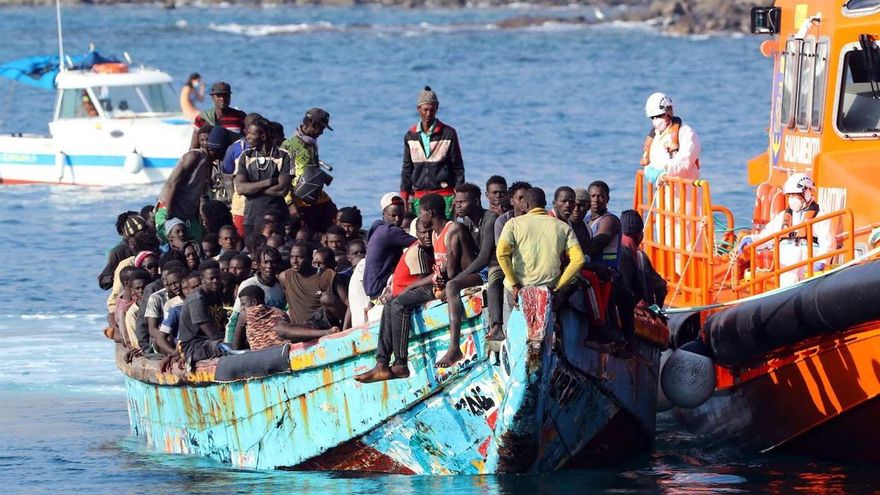
Canary Islands In the nine days since October began, it has received 4,531 immigrants arriving in 53 boats, at a rate of 503 people a day, unprecedented numbers since the “cayuco crisis” of 2006, when the Canary Route marked its all-time high.
According to official figures to which EFE has had access, with the arrivals tonight and early morning to Tenerife, Fuerteventura, Lanzarote and Gran Canariathere are 19,507 immigrants rescued in the Canary Islands so far this year, when as of September 30 there were 14,976.
The historical maximum number of arrivals to the islands along the Canary Route dates back to the so-called “cayuco crisis” of 2006, the year in which 31,678 people arrived on the islands. The second highest figure (and record for the current stage) corresponds to 2020, with 23,271 rescues, according to the balance sheets published every 15 days by the Ministry of the Interior.
The incessant flow of cayucos that the Canary Islands have received in the last week, very focused on The iron and Tenerife and with several boats with more than 200 occupants, has made the Route already exceed all arrivals in 2022 by 3,825 people (15,682).
Stockings way above fall 2020
In the first nine days of October, 503 people a day have arrived on the islands.
In 2020, the Canary Route also experienced a large peak in the months of October and November, which accounted for 58% of the arrivals that year (13,485 immigrants out of a total of 23,271).
If those two months are examined by fortnights (these are the data published by the Interior), it can be seen that even then the arrival rates for this month of October were not observed.
From October 1 to 15, 2020, an average of 134 people per day were rescued or reached the coast of the Canary Islands; From October 16 to 31 there were 206 a day; from November 1 to 15, 356 per day; and from November 16 to 30, 187 a day. None of those fortnights of frenetic activity reached the average for this October.
In 2020, the arrival of 13,485 people in the Canary Islands in two months caused the system to collapse, leaving behind images such as more than 2,300 people sleeping crowded together for days on the floor of the dock. Arguineguindue to lack of resources.
Jams in the network of first reception and police affiliation
This time, the system has only collapsed punctually, in a couple of days in which the new arrivals have been forced to sleep one night on the docks of Reef (Lanzarote, from October 1 to 2) and Los Cristianos (Tenerife, from October 6 to 7).
And it has done so fundamentally in the first reception network, in the Temporary Care Centers for Foreigners (CATE) where all those who arrive by boat on the islands spend up to 72 hours in police custody, while their affiliation is completed, because the Ministry of Inclusion has assured EFE that the humanitarian reception resources of the Secretary of State for Migration on the islands continue to have places available.
However, the number of reception places for minors under the guardianship of the Government of the Canary Islandswhich already has around 3,000 children under its responsibility (at the beginning of 2019 there were only 281) and has been forced to transfer all those arriving these days from El Hierro to Gran Canaria and Tenerife, to decongest the island’s centers with less population and resources.
Differences with the days of Arguineguín
Why in these nine days of October, with greater pressure of daily arrivals than in 2020, have the scenes at the Arguineguín pier not been repeated or, if they have, has it been only for one night and with a maximum of 200 people?
The answer lies in several factors: the first of them is that in 2020 the reception network in the Canary Islands was almost dismantled, to the point that the Secretary of State for Migration had to set up camps in a hurry and convert them into emergency shelters. hotels without activity for the pandemic. Now, Migrations has a network of around 5,000 places.
The second factor is found in the pandemic itself, which forced new arrivals to be quarantined in spaces that turned out to be unhealthy, as the Ombudsman denounced in its reports, which caused some immigrants to chain one quarantine with another by mixing them. in the same center with groups arriving later. That situation no longer exists.
And the third difference is that in 2020 the ports and airports were closed to migrants so that they did not move to the peninsula, until several judicial resolutions forced the Police to respect the right of these people to move through the national territory if they did not. They were expelled within the legal deadlines.
The Police then assured that the travel restrictions they imposed were due to the health limitations in force in several autonomous communities. The NGOs understood that it was an attempt to retain those who arrived on the boats on the islands, in a dynamic that reproduced in the Canary Islands, in their opinion, what the EU had already tried in Lampedusa (Italy) and Lesvos (Greece). .
The Canary Islands ask for urgent help with minors
That circumstance does not occur at this time either, at least with adults. In fact, the central government is transferring from the Canary Islands to resources on the peninsula in a few days those who arrive by boat to the Canary Islands to decongest the reception network.
The same does not happen with minors, a group with which the Government of the Canary Islands continues to demand mandatory solidarity measures. Since 2021, the other autonomous communities have only welcomed 365 minors who arrived in the Canary Islands (and not all).
For this reason, both the previous Government of Angel Victor Torres (PSOE) as the current one of Fernando Clavijo (CC) have been insistently demanding a legal reform that replaces voluntary solidarity with a mandatory distribution of minors among all autonomies, because it recognizes that it is incapable of providing the care that 3,000 minors require in terms of reception, health, education and integration.
This same Wednesday the 11th, the Sectoral Conference on Children will address how to comply with the agreement that was already closed last year so that in 2023 the rest of the autonomous communities assume the guardianship of 342 immigrant minors now welcomed in the Canary Islands.
















